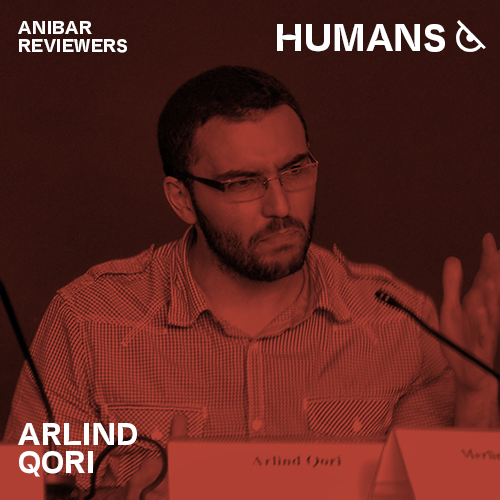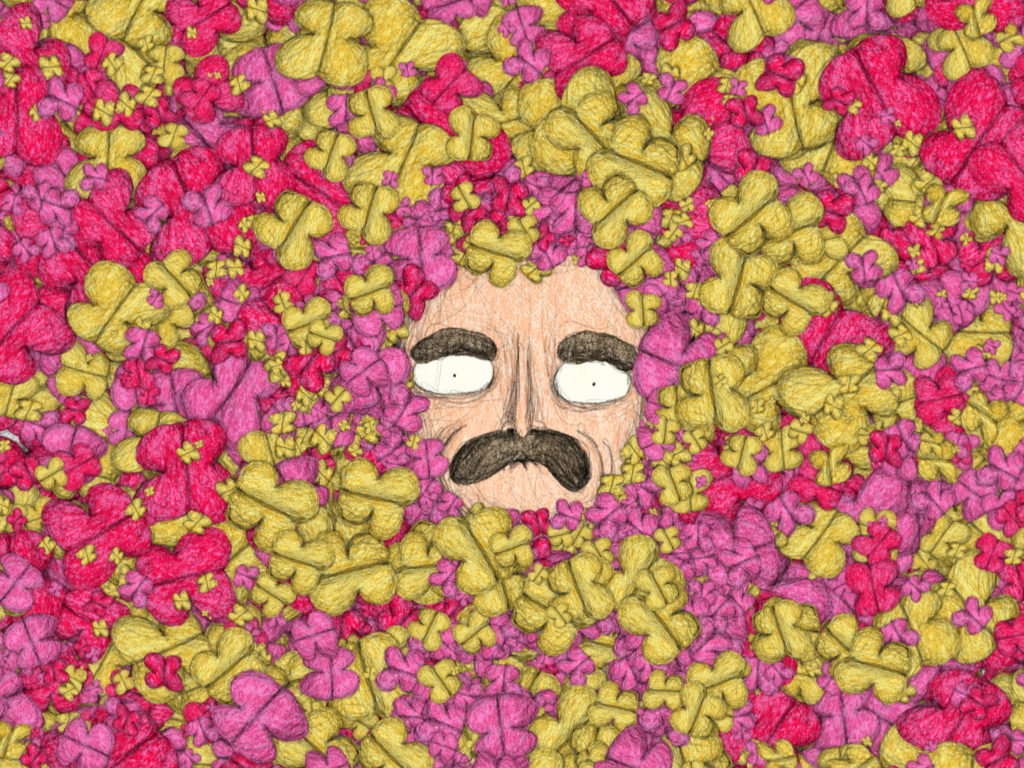Arlind Qori: Student Competition IV

Arlind Qori
“Pile”
The movie “Pile” carries two possible lines of interpretation. In the first we have a brief history of the transition from a pre-capitalist (medieval) society, characterized by a symbiotic relationship with nature, initially to a capitalist-industrial society and then to a capitalist-postindustrial one. It seems that the author sharpens the peak of criticism especially towards the last stage, with its disarray and alienation – all this under the fevers of the speed of image multiplication. It is not to no purpose that historian Perry Anderson defines the transition from industrial to postindustrial capitalism as the replacement of the machinery image with the image machinery.
However, the film also has a second line of possible interpretation. The transition from one society to another not only implies the historical continuity in time, but it is also placed in space: at the top of the pyramid is today’s hyper-capitalist society, with its privileged, which can only stand above the arduous and underground work of a multitude of people, the exploitation of whose work shows that within the same era different times and logic coexist – both within a society and between the center and the periphery of the global economy.
“Nestor”
The movie “Nestor” shows the mania of the contemporary man with order, with the preservation of everything in its “natural” place. The boat that sways – somewhere stronger and somewhere slower – from the waves of the sea, a symbol of social change beyond the control of individual actors, disturbs the status quo of the common person, who in change does not see the possibility of improvement and emancipation, but the uncertainty. Nevertheless, despite the unstoppable efforts of the film’s character to put things in place, to maintain the usual rhythm of the story, the latter produces waves and, in the end, tousles everything inside the boat. From the repetition of the character’s pencil knocking on the folding of the cupboards caused by the sea storm, it seems as if in the end the author will show us that the catastrophe is not an intervention by forces outside of human influence, but the result of not changing the behavior of the latter or, more precisely, of not daring to imagine and build a new society. A newness will come. It is up to us whether it will have the appearance of a natural desolation and social obscurantism or really pave the way for human emancipation.
“I Just Call It Love”
The movie “I Just Call It Love” appears under a rhythmic music what can be called the world of life (lebenswelt), with the throng of otherness, motion, vagueness of passion. It is not entirely just for the human life, but also for life in general, for unity of what can be called a cosmic order. Of course, this cosmic order (unity) of beings has its contradictions, it is endangered at every moment – by ignoring the Other as nature, species, different social/national groups, etc. But it seems like the author invites us to look beyond every local logic and to look above the entirety of the world of life, which can be preserved only through love. A love which is not only an intimate expression of passion, but an awareness of being part of a wholeness without which our individual will be poor, in every meaning of the word.
“1000 Dreams: Zenti The Invincible”
Zenti is a character who lives in a surreal world, a cosmic traveler of a society that has transcended its physical boundaries, but seems to reproduce the same social relationships and way of life – from the concrete to the silent earth, where the God of Money (Mamoni) continues to rule among people. But Zenti is a stranger among men. For a century he has been searching for his lost wife. He wanders in different dimensions, planets, to find what kept him spiritually alive, but in vain. He has seen everything, even “a piece of God”, but still remains alone, in search of lost love. “I have died thousands of times after I lost you,” – he said imaginatively to his wife, “but I have lived thousands of dreams looking for you.” In a strong dialectical turn, his life is both an endless misery and an unstoppable search for love, which, with the closing of the eyes, plunges one into new, petrified and thrilling worlds at the same time. This unstoppable search for lost love makes one invincible in the face of any adversity, like our invincible Zent.
“Tales of Creation”
The movie “Tales of Creation” aims to produce a demonstration of the logic of species’ evolution – combining not only the logic of the strongest (the law of the jungle), but also the adaptation of natural and social species to more complex forms. The law of the strongest appears both in the relationship between man and animal (man as their hunter), and in the way animals are sacrificed in today’s food industry and their bones are used as ornaments of the aesthetic industries. The paradox of the fossil fuel industry, which is based, in essence, on the fossils of various buried organisms, should not be ignored either. In the end, man, this being that would be presumed triumphant in the process of species evolution, is found as an alien in the world he has created, alienated to the point that he dreams of escaping from his own civilized creature.
“Bye Little Block!”
The movie “Bye little block!” starts with a phone call where a husband communicates to his wife that he has finally found a buyer for their house and they will leave it. From the eyes of the woman drops a tear of melancholy, a heavy stone, which rolls through her neighborhood bringing to our attention the daily life of the inhabitants. The focus is on several characters: from the elderly on benches switching heads, to the crawling clerk, the bullying teenager, and so on. But the woman remains the main character and her melancholy in regards to the house and the context from which she will break away, apparently against her will. In the end, in an even more surreal escape than the other events, the ghost (or her soul) detaches from the balcony of her apartment and joins the Moon, leaving the neighborhood without any light. She is losing her social habitat, but the latter seems to have lost its soul.
“I, Alive”
The movie “I, Alive” tells the story of a man in a coma between life and death. He is probably the victim of a suicide attempt. He starts with the question “what happens after death?” which the character seems to be trying. It is neither beautiful nor horrible, as in religious narratives, but simply empty. Emptiness and loneliness; the mother’s stomach and the coffin – the pre-life and the death as two formally similar times and logics but essentially opposite ones. It is in this anxiety that the desire for life triumphs, aided by the idea of the mother as the giver, supporter and amplifier of life.
“Twigs”
The movie “Twigs” is a critique of phallocentrism both as a worldview logic and as a hierarchical way of organizing social life. The story begins with a woman who seeks to erotically attract the attention of her husband, who cannot be separated from the mobile phone which is like a small window that connects him to the big world. She serves him, approaches him intimately, but he leaves. It seems as if it has already squeezed the fluid of life and instead of her, he prefers masturbation in the toilet of the house. But, while masturbating, his penis falls off in his hand, turning him into a miserable being – with a cactus head and organs, a symbol of a life in the desert. In the end, the woman, freed by the “emasculation” of her husband, masturbating with his fallen cactus-shaped penis, has gained her autonomy, near which her former master survives.
“Milkoffe”
The film “Milkoffe” shows a piece of American life, where a privileged clerk (probably a banker), a representative or a defender of the interests of the economic-political elite of that country, stops the car at a diner and orders a coffee with milk. In the background a snippet from a propaganda speech on freedom as a myth of the American social life can be heard. In front of him sits a man wearing a tank top with a beer in his hand, characteristic features of the American worker. They stare at each other, but for a moment it seems to the worker that he is not equal at the table, but merely a grain of undissolved sugar in the cup of coffee and milk of the gentleman across from him. The elite clerk worries that the sugar is not dissolving – a symbol of the resistance of the workers and the people of the subordinate classes of that country, and shakes the glass even harder, while after each shake the worker breathes harder and gasps sweatier. Until in the end a pistol shot puts an end to everything…
“Catgot”
The film “Catgot” is an abstract anthem of the beauty of life as a variety of beings, lifestyles and experiences, where from the smallest dots explode emotions accompanied by music that show the rhythm of life. Life is like a fountain, its beauty is found in the diverse, in the omnipresent, in the movement and going towards the complex, the colorful. Everything is accompanied by music whose notes are like the strikes of water droplets on the surface.

Arlind Qori is an activist at the Organizata Politike in Albania. He also teaches at the University of Tirana on subjects such as political philosophy and critique of ideology.
-The opinions, findings, and conclusions or recommendations expressed herein are those of the Author(s) and do not necessarily reflect those of the Anibar Festival





